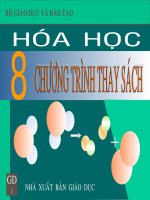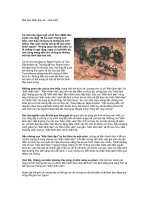Tài liệu Bài 9: ICA by Maximum Likelihood Estimation ppt
Bạn đang xem bản rút gọn của tài liệu. Xem và tải ngay bản đầy đủ của tài liệu tại đây (364.42 KB, 17 trang )
9
ICA by Maximum
Likelihood Estimation
A very popular approach for estimating the independent component analysis (ICA)
model is maximum likelihood (ML) estimation. Maximum likelihood estimation is
a fundamental method of statistical estimation; a short introduction was provided in
Section 4.5. One interpretation of ML estimation is that we take those parameter
values as estimates that give the highest probability for the observations. In this
section, we show how to apply ML estimation to ICA estimation. We also show its
close connection to the neural network principle of maximization of information flow
(infomax).
9.1 THE LIKELIHOOD OF THE ICA MODEL
9.1.1 Deriving the likelihood
It is not difficult to derive the likelihood in the noise-free ICA model. This is based
on using the well-known result on the density of a linear transform, given in (2.82).
According to this result, the density
p
x
of the mixture vector
x = As
(9.1)
can be formulated as
p
x
(x)=j det Bjp
s
(s)=j det Bj
Y
i
p
i
(s
i
)
(9.2)
203
Independent Component Analysis. Aapo Hyv
¨
arinen, Juha Karhunen, Erkki Oja
Copyright
2001 John Wiley & Sons, Inc.
ISBNs: 0-471-40540-X (Hardback); 0-471-22131-7 (Electronic)
204
ICA BY MAXIMUM LIKELIHOOD ESTIMATION
where
B = A
1
,andthe
p
i
denote the densities of the independent components.
This can be expressed as a function of
B =(b
1
:::b
n
)
T
and
x
,giving
p
x
(x)=j det Bj
Y
i
p
i
(b
T
i
x)
(9.3)
Assume that we have
T
observations of
x
, denoted by
x(1) x(2) ::: x(T )
. Then the
likelihood can be obtained (see Section 4.5) as the product of this density evaluated
at the
T
points. This is denoted by
L
and considered as a function of
B
:
L(B)=
T
Y
t=1
n
Y
i=1
p
i
(b
T
i
x(t))j det Bj
(9.4)
Very often it is more practical to use the logarithm of the likelihood, since it is
algebraically simpler. This does not make any difference here since the maximum of
the logarithm is obtained at the same point as the maximum of the likelihood. The
log-likelihood is given by
log L(B)=
T
X
t=1
n
X
i=1
log p
i
(b
T
i
x(t)) + T log j det Bj
(9.5)
The basis of the logarithm makes no difference, though in the following the natural
logarithm is used.
To simplify notation and to make it consistent to what was used in the previous
chapter, we can denote the sum over the sample index
t
by an expectation operator,
and divide the likelihood by
T
to obtain
1
T
log L(B)=E f
n
X
i=1
log p
i
(b
T
i
x)g + log j det Bj
(9.6)
The expectation here is not the theoretical expectation, but an average computed from
the observed sample. Of course, in the algorithms the expectations are eventually
replaced by sample averages, so the distinction is purely theoretical.
9.1.2 Estimation of the densities
Problem of semiparametric estimation
In the preceding, we have expressed
the likelihood as a function of the parameters of the model, which are the elements
of the mixing matrix. For simplicity, we used the elements of the inverse
B
of the
mixing matrix. This is allowed since the mixing matrix can be directly computed
from its inverse.
There is another thing to estimate in the ICA model, though. This is the densities of
the independent components. Actually, the likelihood is a function of these densities
as well. This makes the problem much more complicated, because the estimation
of densities is, in general, a nonparametric problem. Nonparametric means that it
THE LIKELIHOOD OF THE ICA MODEL
205
cannot be reduced to the estimation of a finite parameter set. In fact the number of
parameters to be estimated is infinite, or in practice, very large. Thus the estimation
of the ICA model has also a nonparametric part, which is why the estimation is
sometimes called “semiparametric”.
Nonparametric estimation of densities is known to be a difficult problem. Many
parameters are always more difficult to estimate than just a few; since nonparametric
problems have an infinite number of parameters,they are the most difficult to estimate.
This is why we would like to avoid the nonparametric density estimation in the ICA.
There are two ways to avoid it.
First, in some cases we might know the densities of the independent components
in advance, using some prior knowledge on the data at hand. In this case, we could
simply use these prior densities in the likelihood. Then the likelihood would really
be a function of
B
only. If reasonably small errors in the specification of these prior
densities have little influence on the estimator, this procedure will give reasonable
results. In fact, it will be shown below that this is the case.
A second way to solve the problem of density estimation is to approximate the
densities of the independent components by a family of densities that are specified
by a limited number of parameters. If the number of parameters in the density family
needs to be very large, we do not gain much from this approach, since the goal was
to reduce the number of parameters to be estimated. However, if it is possible to use
a very simple family of densities to estimate the ICA model for any densities
p
i
,we
will get a simple solution. Fortunately, this turns out to be the case. We can use an
extremely simple parameterization of the
p
i
, consisting of the choice between two
densities, i.e., a single binary parameter.
A simple density family
It turns out that in maximum likelihood estimation, it is
enough to use just two approximations of the density of an independent component.
For each independent component, we just need to determine which one of the two
approximations is better. This shows that, first, we can make small errors when we
fix the densities of the independent components, since it is enough that we use a
density that is in the same half of the space of probability densities. Second, it shows
that we can estimate the independent components using very simple models of their
densities, in particular, using models consisting of only two densities.
This situation can be compared with the one encountered in Section 8.3.4, where
we saw that any nonlinearity can be seen to divide the space of probability distributions
in half. When the distribution of an independent component is in one of the halves,
the nonlinearity can be used in the gradient method to estimate that independent
component. When the distribution is in the other half, the negative of the nonlinearity
must be used in the gradient method. In the ML case, a nonlinearity corresponds to
a density approximation.
The validity of these approaches is shown in the following theorem, whose proof
can be found in the appendix. This theorem is basically a corollary of the stability
theorem in Section 8.3.4.
206
ICA BY MAXIMUM LIKELIHOOD ESTIMATION
Theorem 9.1 Denote by
~p
i
the assumed densities of the independent components,
and
g
i
(s
i
)=
@
@s
i
log ~p
i
(s
i
)=
~p
0
i
(s
i
)
~p
i
(s
i
)
(9.7)
Constrain the estimates of the independent components
y
i
= b
T
i
x
to be uncorrelated
and to have unit variance. Then the ML estimator is locally consistent, if the assumed
densities
~p
i
fulfill
E fs
i
g
i
(s
i
) g
0
(s
i
)g > 0
(9.8)
for all
i
.
This theorem shows rigorously that small misspecifications in the densities
p
i
do
not affect the local consistency of the ML estimator, since sufficiently small changes
do not change the sign in (9.8).
Moreover, the theorem shows how to construct families consisting of only two
densities, so that the condition in (9.8) is true for one of these densities. For example,
consider the following log-densities:
log ~p
+
i
(s)=
1
2 log cosh(s)
(9.9)
log ~p
i
(s)=
2
s
2
=2 log cosh(s)]
(9.10)
where
1
2
are positive parameters that are fixed so as to make these two functions
logarithms of probability densities. Actually, these constants can be ignored in the
following. The factor 2 in (9.9) is not important, but it is usually used here; also, the
factor
1=2
in (9.10) could be changed.
The motivation for these functions is that
~p
+
i
is a supergaussian density, because
the
log cosh
function is close to the absolute value that would give the Laplacian
density. The density given by
~p
i
is subgaussian, because it is like a gaussian log-
density,
s
2
=2
plus a constant, that has been somewhat “flattened” by the
log cosh
function.
Simple computations show that the value of the nonpolynomial moment in (9.8)
is for
~p
+
i
2E f tanh(s
i
)s
i
+(1 tanh(s
i
)
2
)g
(9.11)
and for
~p
i
it is
E ftanh(s
i
)s
i
(1 tanh(s
i
)
2
)g
(9.12)
since the derivative of
tanh(s)
equals
1 tanh(s)
2
,and
E fs
2
i
g =1
by definition.
We see that the signs of these expressions are always opposite. Thus, for practically
any distributions of the
s
i
, one of these functions fulfills the condition, i.e., has the
desired sign, and estimation is possible. Of course, for some distribution of the
s
i
the nonpolynomial moment in the condition could be zero, which corresponds to the
ALGORITHMS FOR MAXIMUM LIKELIHOOD ESTIMATION
207
case of zero kurtosis in cumulant-based estimation; such cases can be considered to
be very rare.
Thus we can just compute the nonpolynomial moments for the two prior distribu-
tions in (9.9) and (9.10), and choose the one that fulfills the stability condition in (9.8).
This can be done on-line during the maximization of the likelihood. This always
provides a (locally) consistent estimator, and solves the problem of semiparametric
estimation.
In fact, the nonpolynomial moment in question measures the shape of the density
function in much the same way as kurtosis. For
g (s) = s
3
, we would actually
obtain kurtosis. Thus, the choice of nonlinearity could be compared with the choice
whether to minimize or maximize kurtosis, as previously encountered in Section 8.2.
That choice was based on the value of the sign of kurtosis; here we use the sign of a
nonpolynomial moment.
Indeed, the nonpolynomial moment of this chapter is the same as the one encoun-
tered in Section 8.3 when using more general measures of nongaussianity. However,
it must be noted that the set of nonlinearities that we can use here is more restricted
than those used in Chapter 8. This is because the nonlinearities
g
i
used must corre-
spond to the derivative of the logarithm of a probability density function (pdf). For
example, we cannot use the function
g (s)=s
3
because the corresponding pdf would
be of the form
exp(s
4
=4)
, and this is not integrable, i.e., it is not a pdf at all.
9.2 ALGORITHMS FOR MAXIMUM LIKELIHOOD ESTIMATION
To perform maximum likelihood estimation in practice, we need an algorithm to
perform the numerical maximization of likelihood. In this section, we discuss dif-
ferent methods to this end. First, we show how to derive simple gradient algorithms,
of which especially the natural gradient algorithm has been widely used. Then we
show how to derive a fixed-point algorithm, a version of FastICA, that maximizes the
likelihood faster and more reliably.
9.2.1 Gradient algorithms
The Bell-Sejnowski algorithm
The simplest algorithms for maximizing likeli-
hood are obtained by gradient methods. Using the well-known results in Chapter 3,
one can easily derive the stochastic gradient of the log-likelihood in (9.6) as:
1
T
@ log L
@ B
=B
T
]
1
+ E fg(Bx)x
T
g
(9.13)
Here,
g(y)=(g
i
(y
i
):::g
n
(y
n
))
is a component-wise vector function that consists
of the so-called (negative) score functions
g
i
of the distributions of
s
i
, defined as
g
i
=(logp
i
)
0
=
p
0
i
p
i
:
(9.14)
208
ICA BY MAXIMUM LIKELIHOOD ESTIMATION
This immediately gives the following algorithm for ML estimation:
B / B
T
]
1
+ E fg(Bx)x
T
g
(9.15)
A stochastic version of this algorithm could be used as well. This means that the
expectation is omitted, and in each step of the algorithm, only one data point is used:
B / B
T
]
1
+ g(Bx)x
T
:
(9.16)
This algorithm is often called the Bell-Sejnowski algorithm. It was first derived in
[36], though from a different approach using the infomax principle that is explained
in Section 9.3 below.
The algorithm in Eq. (9.15) converges very slowly, however, especially due to
the inversion of the matrix
B
that is needed in every step. The convergence can be
improved by whitening the data, and especially by using the natural gradient.
The natural gradient algorithm
The natural (or relative) gradient method sim-
plifies the maximization of the likelihood considerably, and makes it better condi-
tioned. The principle of the natural gradient is based on the geometrical structure of
the parameter space, and is related to the principle of relative gradient, which uses
the Lie group structure of the ICA problem. See Chapter 3 for more details. In the
case of basic ICA, both of these principles amount to multiplying the right-hand side
of (9.15) by
B
T
B
. Thus we obtain
B / (I + E fg(y)y
T
g)B
(9.17)
Interestingly, this algorithm can be interpreted as nonlinear decorrelation.This
principle will be treated in more detail in Chapter 12. The idea is that the algo-
rithm converges when
E fg(y)y
T
g = I
, which means that the
y
i
and
g
j
(y
j
)
are
uncorrelated for
i 6= j
. This is a nonlinear extension of the ordinary requirement
of uncorrelatedness, and, in fact, this algorithm is a special case of the nonlinear
decorrelation algorithms to be introduced in Chapter 12.
In practice, one can use, for example, the two densities described in Section 9.1.2.
For supergaussian independent components, the pdf defined by (9.9) is usually used.
This means that the component-wise nonlinearity
g
is the tanh function:
g
+
(y )=2tanh(y )
(9.18)
For subgaussian independent components, other functions must be used. For exam-
ple, one could use the pdf in (9.10), which leads to
g
(y ) = tanh(y ) y
(9.19)
(Another possibility is to use
g (y ) = y
3
for subgaussian components.) These
nonlinearities are illustrated in Fig. 9.1.
The choice between the two nonlinearities in (9.18) and (9.19) can be made by
computing the nonpolynomial moment:
E f tanh(s
i
)s
i
+(1 tanh(s
i
)
2
)g
(9.20)









